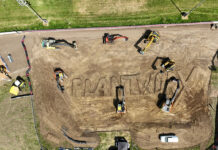
A virtual model of a physical building, digital twins pair the digital and physical worlds so real-time data can be stored, accessed and shared anytime, anywhere. Digital twins optimise the operation and maintenance of physical assets, systems and processes, and enable construction businesses to prevent problems before they emerge and identify better opportunities to bolster productivity.
However, there seems to be some contention when it comes to a digital twin’s definition, partly because the supply chain sees digital twins in different lights. Stuart Bell, sales and marketing director at GroupBC, offers insight into the definitions of a digital twin, and broaches the question: who is responsible for its management?
THE industry has been slow to adopt new technologies and ways to work, however digital twins are having a positive impact across the supply chain; helping to store and manage data, use data to enhance the build and future operation of an asset, and prevent risks.
Since the mid-90s, the industry has been trying to improve how its workforce manages information. Email took over from paper and this extended to the internet, which provides a common interface where information can be accessed.
The proliferation of broadband and mobile means the industry has been able to capitalise on technology and make it business as usual. Standardisation has also helped to place digital advancement on a trajectory. It hasn’t been pockets of excellence but something which has seen huge investment for it to become part of the construction industry’s culture.
But for some within the supply chain, the definition of a digital twin is still a hazy topic. Whilst key stakeholders and the majority of Tier 1 organisations are fluent in the benefits of digital twins, others are unfortunately lagging behind – unsure of how beneficial digital twins are and whose responsibility it is to manage them.
What is a digital twin?
Although definitions of digital twins can vary throughout the supply chain, the industry can unanimously agree that it is a digital representation of a physical asset which provides up-to-date data on the real world operation of a built asset. A digital twin houses information on a given asset; such as its objects and states. Digital twins cover the entire lifecycle of a physical asset, connecting products and services so they can be viewed and – if necessary – acted upon during construction and on handover to the asset owner.
Even though its definition is not set in stone, it is essential for industry professionals up and down the supply chain to see that the digital twin is more than a file containing everything which relates to an asset. Yes it houses data, but is also assures the information is spatially-connected and held altogether in the right place, to maximise productivity and product performance.
A digital twin is, therefore, all about connection. It would merely be a virtual representation of a building with no real-time value if products and services were not connected. For instance, think of a digital twin as a connected data ecosystem, where an asset’s geospatial surrounding is also connected to other systems. A digital twin isn’t something which sits in isolation. It is connected, through sensors, to the physical asset to give a true to life, equal image of the built asset.
Who manages a digital twin?
The responsibility of who owns the digital twin when it is handed over to the asset owner is a complex factor, which puts to debate questions on ownership and accountability. Some in the industry believe the digital twin is everyone’s responsibility: the operations and FM teams, company administrators and not to mention key stakeholders. The digital twin is able to access live product specifications so the supply chain can procure information differently and make better decisions to assure the efficient performance of the physical asset.
On the contrary, others may argue that administering responsibility to all parties is a recipe for digital chaos. They will express the ‘manager’ is whoever the asset owner contractually states. The way that information and data are currently presented and stored, there is the capacity for businesses to be very specific in terms of who is responsible for updating information models when and where.
The industry is well-versed when it comes to speaking on its fragmentation. However, as a digital twin is at its core a connected data ecosystem, surely it is a great way to unite the supply chain to enable a collaborative working environment for the benefit of all?
There are multiple views on structured data, and a digital twin is another view on that data. The digital twin utilises the physical location of an asset as the primary navigation route, to reflect real-time performance, enable cost savings and drive efficiencies across the supply chain. And it can achieve all of this, and much more, through interconnected data systems which members of a project’s supply chain can have access to. Surely that is the carrot to cultivating greater adoption of this technology across the sector?








